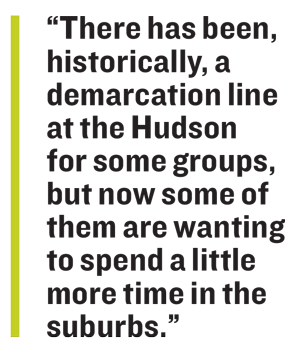Trending
Goodbye HFF, hello JLL

In early July, Jones Lang LaSalle closed on its landmark deal to acquire one of its biggest competitors in the office and multifamily markets. While the $1.8 billion acquisition of HFF was purportedly motivated by HFF’s depth in the capital markets, senior managing director for HFF — now JLL —Jose Cruz said the merger will play to the respective strengths of each group in the tri-state area. With about 1,050 employees before the merger, HFF raked in $650 million in revenue for 2018. Morriston, New Jersey-based Cruz, who was part of HFF for more than 10 years, said that the merger will be an opportunity to grow within a well-established company with superior resources.
Cruz spoke to The Real Deal about the state of the market as private and institutional investors begin to look outside New York City to push for higher yields and cope with the economic cycle.
What are some trends you’re seeing in commercial investment in the tri-state region? At this point, we’re seeing really good activity on multifamily product throughout the suburban tri-state markets — New Jersey, Fairfield County and Long Island, and even into parts of upstate New York. There is a lot of crossover and a lot of capital that doesn’t necessarily differentiate between the counties. As long as the transactions make sense, a lot of the capital that is in New Jersey will go to other markets. Regardless of the product, whether it is retail or industrial, office or multifamily, it’s difficult to find good product.
Industrial properties have been in high demand throughout the region. What’s in store for that sector? The challenge with industrial is finding enough product on the market that is available to purchase. The supply side of that market is challenging these days. Most people are in aggregate mode rather than putting deals on the market, although what is trading is trading at really good pricing.
In terms of per-square-foot land prices, we’re seeing that at record levels. And it’s not only a typical A or B Class product, but we’re seeing very strong demand for flex-type product throughout the area, with higher office finishes and slightly lower ceiling heights. But that product is trading at aggressive cap rates throughout the tri-state area. Per-square-foot pricing, depending on the market and location, is north of $100 per square foot.
 How does 2019 to date compare with where the HFF team was with industrial just one year ago? We’ve been much more active in the industrial front in 2019. We expected there would be a lot more product in the market, and that is the one thing holding back the activity. It’s not a lack of demand or a lack of capital available for industrial or a lack of positive underwriting. It’s just a lack of product. There are some good opportunities to buy land and develop property, which I think is what a lot of groups are looking at to develop yield, so we’re seeing land prices move up.
How does 2019 to date compare with where the HFF team was with industrial just one year ago? We’ve been much more active in the industrial front in 2019. We expected there would be a lot more product in the market, and that is the one thing holding back the activity. It’s not a lack of demand or a lack of capital available for industrial or a lack of positive underwriting. It’s just a lack of product. There are some good opportunities to buy land and develop property, which I think is what a lot of groups are looking at to develop yield, so we’re seeing land prices move up.
Christian Ulbrich of JLL said the acquisition of HFF is a long-term play to increase the firm’s presence in the capital markets. How do you feel that translated to the competition and market share JLL had versus HFF in the Garden State prior to the merger? No comment.
What’s different now that you’re a part of JLL? I’m excited about working with everyone at [JLL] and having access to the leasing people, the management and all of the service lines that they offer. Having access to all of them and their touch points and people and relationships adds to what we’re doing. Before, we didn’t have that. We were a much smaller company and, thankfully, we had a big footprint, but now, with in-depth resources behind us, there is a lot more we can do.
We’ve also heard that demand for tri-state suburban multifamily inventory should increase with the passing of New York’s rent law. Do you agree? I think the jury is still figuring out if the New York rent regulation will drive more capital. We’ve definitely been getting more inquiries from groups that haven’t historically been involved and want to understand a bit more. There has been, historically, a demarcation line at the Hudson for some groups, but now some of them are wanting to spend a little more time in the suburbs.
We’ve also seen suburban office leasing and sales activity slow down in the last two quarters. As someone who has managed several large suburban office trades in recent years, do you see this being related to the winding down of the economic cycle? I don’t know that I have seen a slowdown in either the number of offerings or demand, but the pricing reflects the risk level associated with these properties throughout [New Jersey]. In terms of capital available, I am not seeing a drop-off in any way. If anything, we’ll see more office transactions in the state take place, assuming all other economic conditions hold.
How have the capital markets reacted to the low interest rates at this stage in the cycle? We continue to see groups use debt to bid aggressively. We’re not seeing any let-up, but we’ll see what the Fed does. [Debt financing] varies — everybody’s business strategy is different -— but lower interest rates for sure continue to help us across all product types. In terms of increasing pricing based on low interest rates, I am not seeing that as much. The deals have to work on an equity perspective, and the lower interest rates continue to help.
What advice would you impart to young brokers trying to break into the business today? At the end of the day, it is a relationship business. There has to be a trust level between the intermediary and the client. That relationship is paramount. There is a lot riding on these transactions — not just money — and at the end of the day, when you have someone’s trust, that is going to help carry the relationship. Specifically, young brokers, [they need] to develop their financial skills, negotiating skills, physical property skills, all of them. But, at the end of the day, you have to develop the relationship.
—This interview was edited and condensed for clarity.




